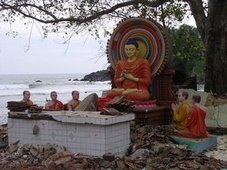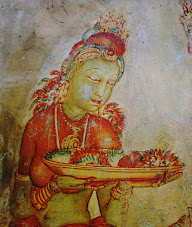
SRI LANKA HOLIDAYS ;THE NIGHT OF SIVA
Be good on 5th March 2008. Be very good. Be good to all.
Sastri: It is an allegory. The wild animals that the hunter fought with are lust, anger, greed, infatuation, jealousy and hatred. The jungle is the fourfold mind, consisting of the subconscious mind, the intellect, the ego and the conscious mind. It is in the mind that these "wild animals" roam about freely. They must be killed. Our hunter was pursuing them because he was a Yogi. If you want to be a real Yogi you have to conquer these evil tendencies. Do you remember the name of the hunter in the story?
Atmanathan: Yes, he was called Suswara.
Sastri: That's right. It means "melodious". The hunter had a pleasant melodious voice. If a person practices Yama and Niyama and is ever conquering his evil tendencies, he will develop certain external marks of a Yogi. The first marks are lightness of the body, health, steadiness, clearness of countenance and a pleasant voice. This stage has been spoken of in detail in the Swetaswatara Upanishad. The hunter or the Yogi had for many years practised Yoga and had reached the first stage. So he is given the name Suswara. Do you remember where he was born?
Atmanathan: Yes, his birthplace is
Sastri: Now, the Yogis call the Ajna Chakra by the name
Atmanathan: Very interesting! But how do you explain his climbing up the bael tree and all the other details of the worship?
Sastri: Have you ever seen a bael leaf?
Atmanathan: It has three leaves on one stalk.
Sastri: True. The tree represents the spinal column. The leaves are threefold. They represent the Ida, Pingala and Sushumna Nadis, which are the regions for the activity of the moon, the sun and fire respectively, or which may be thought of as the three eyes of Shiva. The climbing of the tree is meant to represent the ascension of the Kundalini Shakti, the serpentine power, from the lowest nerve centre called the Muladhara to the Ajna Chakra. That is the work of the Yogi.
Atmanathan: Yes, I have heard of the Kundalini and the various psychic centres in the body. Please go on further; I am very interested to know more.
Sastri: Good. The Yogi was in the waking state when he began his meditation. He bundled up the birds and the animals he had slain and, tying them on a branch of the tree, he rested there. That means he had fully conquered his thoughts and rendered them inactive. He had gone through the steps of Yama, Niyama, Pratyahara, etc. On the tree he was practising concentration and meditation. When he felt sleepy, it means that he was about to lose consciousness and go into deep sleep. So he determined to keep awake.
Atmanathan: That is now clear to me; you certainly do explain it very well. But why did he weep for his wife and children?
Sastri: His wife and children are none other than the world. One who seeks the Grace of God must become an embodiment of love. He must have an all-embracing sympathy. His shedding of tears is symbolical of his universal love. In Yoga also, one cannot have illumination without Divine Grace. Without practising universal love, one cannot win that Grace. One must perceive one's own Self everywhere. The preliminary stage is to identify one's own mind with the minds of all created beings. That is fellow-feeling or sympathy. Then one must rise above the limitations of the mind and merge it in the Self. That happens only in the stage of Samadhi, not earlier.
Atmanathan: Why did he pluck and drop the bael leaves?
Sastri: That is mentioned in the story only to show that he had no extraneous thoughts. He was not even conscious of what he was doing. All his activity was confined to the three Nadis. The leaves, I have said before, represent the three Nadis. He was in fact in the second state, namely, the dream state, before he passed into the deep sleep state.
Atmanathan: He kept vigil the whole night, it is said.
Sastri: Yes, that means that he passed through the deep sleep state successfully. The dawning of day symbolises the entrance into the Fourth state called Turiya or superconsciousness.
Atmanathan: It is said that he came down and saw the Lingam. What does that mean?
Sastri: That means that in the Turiya state he saw the Shiva Lingam or the mark of Shiva in the form of the inner lights. In other words, he had the vision of the Lord. That was an indication to him that he would realise the supreme, eternal abode of Lord Shiva in course of time.
Atmanathan: So it appears from what you say that the sight of the lights is not the final stage?
Sastri: Oh no! That is only one step, albeit a difficult one. Now think of how the story continues. He goes home and feeds a stranger. A stranger is one whom you have not seen before. The stranger is no other than the hunter himself, transformed into a new person. The food was the likes and dislikes which he had killed the previous night. But he did not consume the whole of it. A little still remained. That was why he had to be reborn as King Chitrabhanu. Going to the world of Shiva (Salokya) is not enough to prevent this. There are other stages besides Salokya. These are Samipya, Sarupya and finally Sayujya. Have you not heard of Jaya and Vijaya returning from Vaikunta?
Atmanathan: Yes, I have understood now.
Click following link to go to the original articleThe Scriptures record the following dialogue between Sastri and Atmanathan, giving the inner meaning of the above story.







































No comments:
Post a Comment